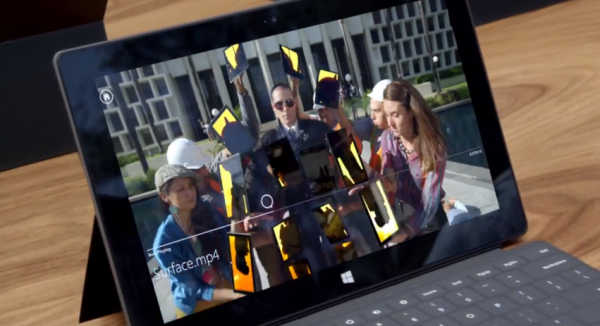I gave up iPad for Microsoft Surface

The original iPad didn't excite me very much. In fact, I was confused what to do with it. Over time, I ended up using the iPad 2, and recently its successor. I’ve also tried the Blackberry PlayBook, the HP TouchPad, and more recently Google Nexus 7.
But, for the first time in a long time, I was very excited to get a tablet -- the new Microsoft Surface. I think Windows RT had a lot to do with it, and the touchscreen aspect.
I worried about the new operating system being touch-based. “How will I use Excel or PowerPoint, or other applications in Windows RT if they are all tile-based?” The good news: I learned that the Windows Desktop is still accessible. So while there normally are lots of tiles, when you start to edit a document, you go back to a familiar desktop and normal Office -- well, its Office 2013 -- so that's cool, too.
Skim the Surface
Surface RT has a nice wide screen. One of the best features is the multi-user support. A lot of people ask me about Surface and each time they hear it can handle multiple users, the light bulb goes off -- such an obvious feature! The feature isn't anything new to Microsoft, but it is a very seamless process on Surface RT. Given that most tablets are touched by many people in the household, it only makes sense that different people to have different applications available. From another perspective, everyone keepx their email and Facebook accounts private. This alone is a great benefit in a family-use scenario.
Microsoft had really taken the touch interface and made it better and more elegant. The tiles are very cool, and the flow of everything is very clean. There are little features that just seem to make life easier. For example, when I browse the web, or read a news article, I can access the “Share” feature and instantly email that article to people. There is some social interaction available, too, but for work purposes, I usually send email. What’s even more helpful is that Surface remembers the last few email distributions I shared to. This means I can send articles relatively quickly. It is so convenient in fact, that even when I am using my laptop to read an article – I pull out Surface and use share feature -- just because of how elegantly the feature works.
What Could Improve
I have stopped completely using my iPad 3 now that I have the Surface. But there are a couple things I would like to see. One is the apps. I am not a heavy app user, but apps I want are not available on Surface. My hope is that they will come soon.
There are also a few nice features I am surprised not to see -- like “reply to all meeting participants that I am running 5 minutes late”, which is on Microsoft's phone OS, but I haven’t found it on Surface and Windows RT.
I talk about the input capabilities below, but one thing missing is voice recognition. I had gotten used to dictating my emails via voice commands -- something I cannot do on Surface.
SkyDrive, Office365, Office 2013
One of my complaints with Apple is the proprietary nature of everything. I won’t go through the painful experience of transferring music from my computer to an Apple device or vice versa. iCloud is another similar proprietary service. For example, I don’t like is that you can only access your pictures from an Apple device, and if you want to store other data, the plans get expensive very quickly.
In contrast, Surface RT is very open in this respect. It is tightly integrated into SkyDrive, which has been around for several years. SkyDrive lets you store pictures as well as documents in the cloud, but is accessible from any device, using an Internet browser, and works very well within Office 365 and 2013. In fact, I sent email with an attachment the other day, and the mail program asked me if I would like to send using SkyDrive. It was so easy! Instead of sending large attachments and clogging up inboxes, you can send links to the files as well as password-protect them. I really want to stress the benefit of being able to access files, pictures and other data from any device. This is a much more open-minded approach, as most people have multiple devices. Ensuring the same experience, regardless of what device you are using at the moment, is key.
Using Office 2013 on Surface is really simple. The click-in keyboard has a built-in trackpad so you have a mouse; this was one of those “aha” moments for me -- Surface RT looks and feels like a tablet, but operates like a laptop or ultrabook. I had full access to Excel, moving the mouse around, dragging cells, and moving text around with the mouse -- everything is very simple. And that is probably the best way to summarize Surface: simple.
Other Features
The charger connects magnetically to the device, which is pretty neat. The click-in keyboard snaps in swiftly due to a magnetic link. Typing on the keyboard is surprisingly easy. You have to learn to trust it. The nice thing is that the on-screen keyboard is available in multiple flavors. You can choose the traditional keyboard, or you can choose from a “two-thumb” keyboard. This splits the keyboard so you can use your left and right thumbs to type on the keyboard; I haven’t seen this before.
One of my favorite features I tell and show everyone is the handwriting recognition. This lets me use my finger to handwrite letters, and a swift conversion puts the script into text. I have written some words in such horrible handwriting, yet the intelligence in the recognition software converted it accurately to text -- very, very cool. And of course, there’s a USB port and ability to connect to an external display. The built-in stand is handy so I don’t have to walk around with an extra case or portable stand.
Is this the Tablet to Buy?
Everyone has different uses for their tablet, so I will give you my background so you can see how it relates to you. My needs are work-oriented. I use the tablet for emails, calendar review, looking at files that are attached in email, and browsing the web.
Most tablets are consumption devices -- good enough to read or consume information, but frustrating to create content. Surface RT acts more like a laptop or ultrabook in this sense, and while I would not choose to write this article on Surface, I can still do work in a pinch.
I certainly do think this is Microsoft’s time – and the more people I talk with, the more root for a company that has made strides in products that you want to own and use because they make life simple.
 Ali Din is senior vice president and CMO at dinCloud, a cloud transformation company that helps organizations rapidly migrate their IT infrastructure to the cloud through its business provisioning services.
Ali Din is senior vice president and CMO at dinCloud, a cloud transformation company that helps organizations rapidly migrate their IT infrastructure to the cloud through its business provisioning services.
